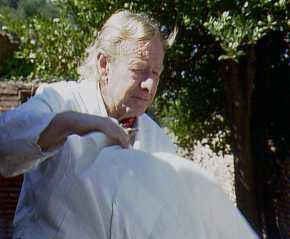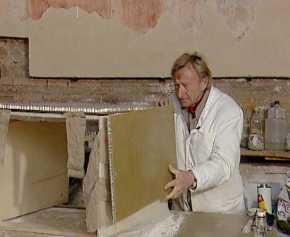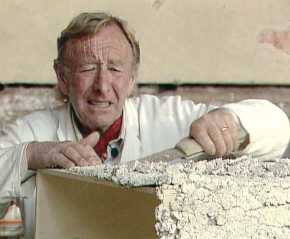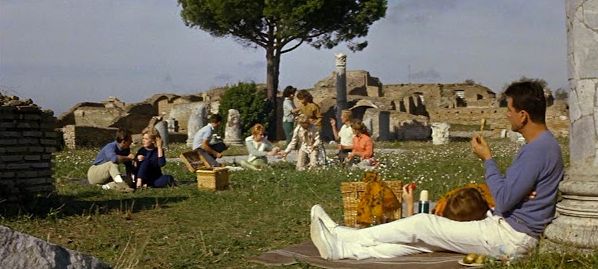For half a century Alberino Vicari (born on the 21st March 1921, married, with one son) worked on the preservation of the wall-paintings at Ostia. He is the last living member of the team which carried out the great campaign of excavations from 1937 to 1942. He retired on the 1st April 1986. This is an excellent opportunity for an interview.
This interview took place in the afternoon of Tuesday, 14th July 1987. We choose a place for ourselves under the pergola outside Pius IX's museum in the grounds of the excavations. Vicari surprises me, he looks like a northern Italian (a bit like Danny Kaye, which makes me think that he descends from the people of Romagna who came to live in the area around Ostia at the end of the last century). I put a bottle of Lacrima d'Arno and two glasses on the table between us, and then ask my first question.
Mr. Vicari, when did you start working here, and what was it like?
"On the 12th March 1936. Working here was nothing new in my family. My father had worked on the excavations of the necropolis of the Laurentine Gate and I was born in Ostia Antica. First of all I was the general dogsbody. I was the postboy and I was also responsible for the directors' transport (Guido Calza and Italo Gismondi). I had to take their bicycles to the station, so everyday I set off on my bike and in each hand I held the handlebar of the gentlemen's bikes. Gismondi obviously appreciated my work and after a while I was given the job of restoring the mosaics."
Soon afterwards Mussolini ordered the start of the excavations, for the World Fair to be held in Rome. Was it a formal order?
"Oh, definitely. There was no way of saying "no"."
Original footage of the excavations in the summer of 1939:
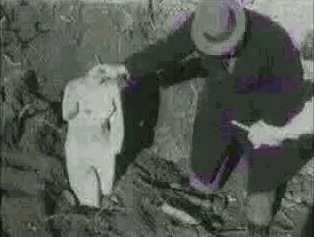 . .
|
The excavations he ordered covered many hectares. Perhaps it was interesting, but irresponsible from a scientific point of view. Were those in charge happy, or worried?
"There was some joy, for those who agreed with Fascist ambitions, and there were some of them here as well. The campaign started in 1937 and Mussolini visited the excavations in 1938. From behind some railings on the first floor of the Horrea of Epagathianus he gazed out over the excavations, as though he were standing on the balcony in Piazza Venezia. The King, Victor Emmanuel III, visited the excavations in the winter of the following year. He saw the House of the Painted Vaults; the building was quite well preserved, the ground-floor ceiling was intact. During the excavations you could get into the building through a window, and I worked on the wall-paintings, which had become my job in the meantime."
Who directed the work during those years?
"Until his death in 1946 the director (he wasn't called "superintendent" in those days) was Guido Calza. For a short time he also directed the Palatine and the Forum in Rome. (Vicari's eyes light up). He was a real gentleman, very neat. Like Gismondi, he'd come here as a young man. From 1935-36 he'd lived in the Castle (the Castle in Ostia) with his first wife. The lady came from the Trieste area and she was very wealthy and a very quiet person. Many years after her death, and only five months before his own, Calza married Raissa de Chirico. She'd come here in 1937-38 as a photographer and secretary; later she became an expert on Roman sculpture. Gismondi, who's famous for his model of ancient Rome in the Museum of the Roman Civilisation, Rome, was only supposed to work at Ostia, but his help was requested by many others.
Then there was Herbert Bloch, the German, who came here just as the great excavation campaign had started. He was specialised in researching building material. As he was well over six feet tall he would send me on all fours into underground passages, looking for brick-stamps. He didn't stay here long. He was a Jew and, for obvious reasons, fled to America in 1939/40. Soon after the war, in 1947 or '48, he came back.
And then there was Russell Meiggs. He was a very nice man, an eccentric, with long hair. He would still be wearing shorts in November! He had a blue jumper that his wife had made for him, which featured the Portus lighthouse flanked by two ships, like a mosaic in the Square of the Guilds. I remember a very strange visit to Portus. One day Meiggs arrived riding a motorcycle with a sidecar."Jump in! We're off to Portus!"."We haven't got a permit", I said, "the ruins are on private land, the Torlonia estate!". Anyway, in the end we went. We got in through a hole in the fence, but we were discovered by the custodians who called the police at Fiumicino. Meiggs explained, long and loud, that he'd entered the grounds because he was finishing a very important book, and he was given a permit on the spot, something the Italians had been asking for in vain for years!"
What was your work during the 1937-1942 campaign?
"In those years I was responsible for cleaning and consolidating the wall-paintings. Many were in danger of falling off the walls and were taken down and moved into storage. Our funds were low and our equipment was primitive: holes were filled in with plaster and sometimes the wall-paintings were held with jute."
How was the great campaign organised?
"There were 200 manual labourers, divided into two groups. The Levantesi group (from the foreman's surname) worked from the theatre to the Laurentine Gate and the Fishmongers' Shops. The Berardi group worked from the Horrea of Epagathianus to the Marine Gate."Old" workmen and custodians were responsible for surveillance.
In the evening I helped to carry everything that had been found to the office, in wheelbarrows. There were mostly a lot of lamps, from thirty to forty every day and in the end we must have found hundreds, thousands.
At that time the archaeological area was almost free of vegetation and you could get malaria. Malaria was finally wiped out in 1946 when the Americans sprayed DDT from planes. In 1942 Gismondi started to plant the pine trees and the custodians used to look after them with real care, just as they used to keep the roads free of weeds. Not like today, now the custodians don't do anything."
Apparently the late-antique walls were not treated quite as they should have been ...
"The late-antique walls weren't preserved. They were uncovered and (he makes a pushing movement with his hands, and shoots me a cheeky look) "crash!" ... down they went. Most of the shards were thrown away, they only kept the vases and lamps that were more or less intact. They weren't entered on the inventory."
Soon after the campaign Calza died, apparently from exhaustion ...
"I wasn't here then. From January 1941 on I was in the army, first in Italy, then a year later I was shipped out to Tunisia. Our ship was bombed and sunk by the Americans. Later I was taken prisoner by the British; from 1943 to 1946 I was sent to several different prisoner-of-war camps, including one in Ashford in Kent, where I saw the V1s and V2s going over."
What happened to Ostia after 1942?
"The area was closed to the public, but the custodians were here. Apparently the Americans stole a lot of stuff; for example, the head of the statue of Victory in the Forum. The head ended up in Sweden; later King Gustaf gave it back."
Did you carry on working on the wall-paintings when you got back?
"Yes, on those in Ostia and in the necropolis at Isola Sacra. Various techniques were tried for restoring the wall-paintings. They're detached in the following way: first you fix the colours with paraloid, then you detach the paintings with special knives together with part of the wall, if need be. Then you fix a board over the painting, which is now ready for transport. Lastly, in the laboratory a layer of two or three millimetres will be preserved and mounted on a new backing; this new backing is plaster made in the same way as Roman plaster.
Up until the Sixties many of the wall-paintings still in their original position were perfectly preserved, but after the airport was built at Fiumicino they started to deteriorate. Within four or five years they were all destroyed. It was a complete disaster. The colours disappeared and fine cracks (craquelé) appeared all over them, perhaps because of the vibrations from the aeroplanes. Consolidation work was started all over again and many wall-paintings were removed into storage."
Which archaeologists did you meet after the War?
"Solin, the Dutchmen Van Essen and Vermaseren. And Russell Meiggs, of course, the "long-haired prof". His hair fell to his shoulders, like a woman. He wasn't interested in eating, he was always working. But in the evening he'd come to the osteria and talk about the excavations and Ostia Antica with the old folk (by the way, my mother told me that during the First World War she stole bread to give to the Austrian prisoners-of-war who were kept in the Castle and made to work in the excavations). Meiggs was very absent-minded and during a conversation he'd keep forgetting what he was talking about. He really didn't behave like a professor, he was a friend and he was always in a good mood. Once he came here with his daughter and went to live in Becatti's house, just opposite the entrance gate. Becatti went to live in Meiggs' house in England. [Russell Meiggs died in his late eighties on 24 June 1989 - JThB].
From 1947 to 1958 Gismondi did some very intense research and lots of test digs, and he drew the large general plan. Unfortunately, when he left Ostia he took all his documents with him. He, too, lived in the Castle, with his wife and two daughters. He was a serious man, and thought highly of those who earned his appreciation. He wasn't one for flattery, but those who worked under him were treated well. He'd known me as a boy and treated me like a son. He died in 1974, but if he came back today he'd send the new generation of custodians packing. He'd organised the custodians like an army unit, now some of them look like drug addicts.
Then came Giovanni Becatti. He got married in the Christian Basilica, just after the war. Then there were other directors, and now Mrs. Arena, who's standing in for the Superintendent."
Did any famous visitors come to the site?
"Of course. For example, King Gustaf of Sweden, Pope John Paul II and Gromyko. I took Eisenhower's wife around the site (she gave me presents from Naples) and some Hollywood stars, as well. One was Kim Novak; I told her she looked like Grace Kelly and that made her very happy, like a little girl. Then there was Gene Tierney, and Kirk Douglas; he came here five or six times and would always ask especially for me, to show him around. He was a pleasant man and spoke good Italian. The scenes of some films were shot here. One was with Charles Boyer, Marcello Mastroianni and Sophia Loren [1955: La Fortuna di Essere Donna - JThB]. Another was with Rock Hudson (he was a serious kind of person, and didn't talk much), Gina Lollobrigida and Sandra Dee [1961; Come September; see photo - JThB]. The favourite places were the Forum, the Basilica, the Curia and the House of the Lararium. I also talked to the famous painter, Giorgio de Chirico (Raissa Calza's first husband, they'd divorced). During his visit to the House of the Muses he concluded that the Romans weren't very bright."They were good builders but, unlike the Etruscans, they didn't know how to paint"."
In your opinion, what has changed the most since 1936?
"Once everyone who worked here came from this area, but not now. Once people really put their heart into working at Ostia, but not any more."
How do you feel after working at Ostia for half a century?
"I can't leave Ostia. I can't imagine not seeing Ostia, not even for one day. I'd feel ill. If I feel sad I like to go walking in the Street of the Fountain, which is always a quiet road with not many tourists. Then I feel close to the ancient inhabitants of the city and I undergo a kind of transformation. I feel as if the ruins were still 'alive'."
What do you do now?
"Now I'm a guide. I prefer groups, because that way there's always someone who's interested (most of them are tired out by the time they get to the House of the Millstones). I prefer Germans, Italians and the British."
Epilogue
I put my pen down and we chat "off the record" for a bit. At about six o'clock we walk towards the way out, along the Decumanus Maximus. When we approach the Street of the Fountain Vicari says, "I can already feel them coming to life!", and when we are in view of the road he adds: "It's a strange sensation, I don't understand it. This road, always in shadow ...".
Jan Theo Bakker
with the kind permission of dr.ssa M.G. Lauro (Monuments and Fine Arts Office for Ostia Antica)
